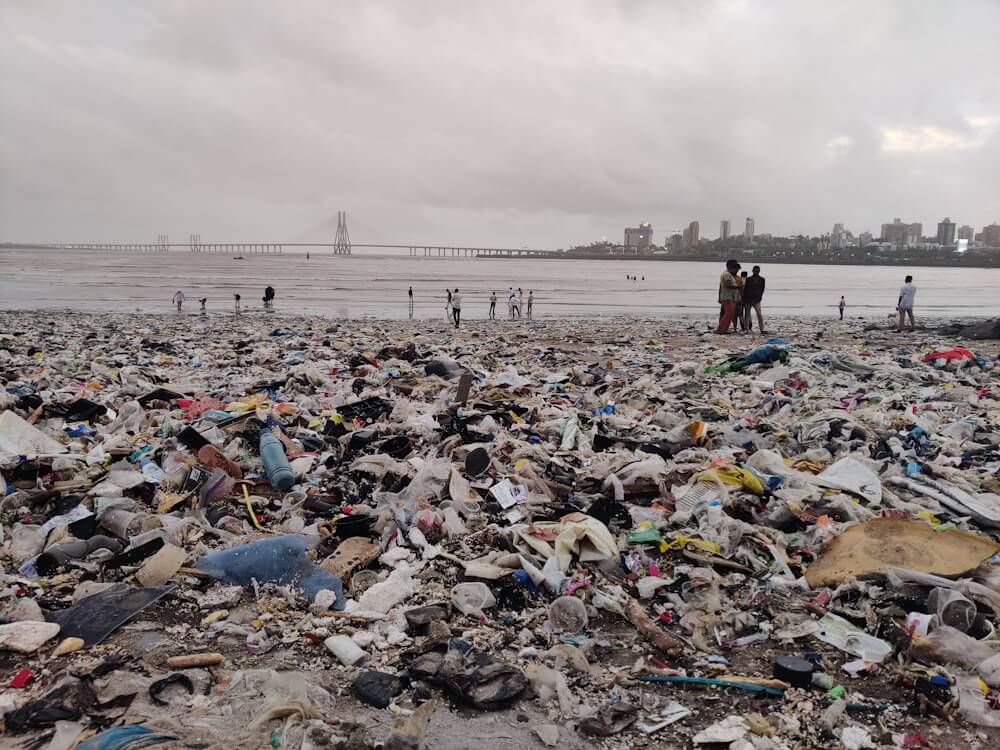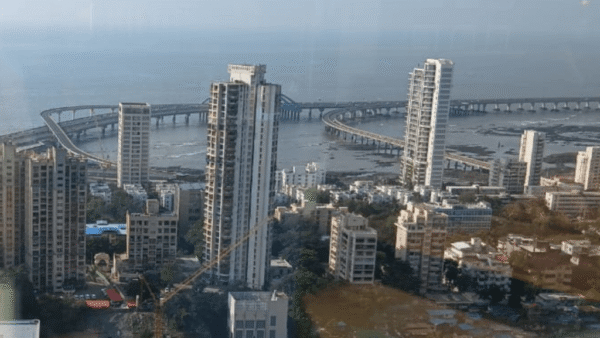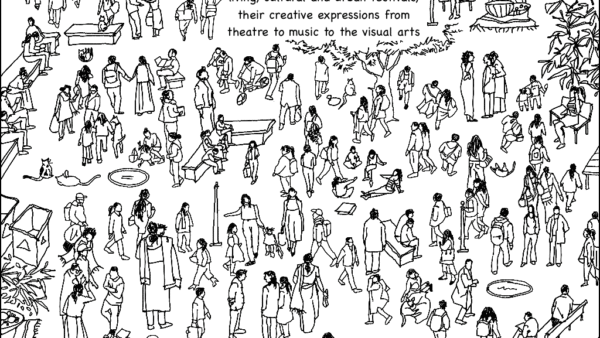In mid-July 2022, two weeks after a national plastic ban was announced, Mumbai’s Mahim beach made news. Heaps of garbage, mostly plastic washed ashore. Hundreds thronged to see what a beach lined with plastic, instead of sand, looked like. This plastic, used and discarded by the city out of its horizon, returned as a stark reminder that even when plastic leaves our sight, it doesn’t go anywhere.
More than at any other time, it returns in the monsoon to remind the city of its inefficiency, carelessness, and disdain for plastic waste. Mumbai’s beaches are a sorry sight but the plastic waste chokes the city’s stormwater drainage network to a point of causing waterlogging in certain areas. Of the 6.3 lakh tonnes of dry waste generated in the city every year, about 20,000 tonnes or 3.2 percent is plastic waste. However, its impact on the city’s waste management and rainwater drainage far exceeds its volume. On average, around 27 percent of the city’s 6,400 metric tonnes of waste generated every day is dry waste, according to the Brihanmumbai Municipal Corporation (BMC).
In 2022, four years after Maharashtra government banned plastic use, only 12,402 of the nearly 20,000 tonnes of plastic waste was recycled which means nearly half ended up in Mumbai’s landfills or waterbodies.[1] Mumbai is not alone. New Delhi, Kolkata, Visakhapatnam, Hyderabad and Chennai continue to report problems of plastic waste choking drains. Bengaluru generates 988.44 tonnes of plastic waste a day, of which only 324.29 tonnes, less than half, is processed.[2] Delhi generates 1,145 tonnes daily with more than half being single-use plastic.[3]
Chennai, which produces 7,188 tonnes of plastic waste annually, showed that single-use plastic was in circulation in 2023, four years after the ban.[4] Hyderabad produces 1,080 tonnes of plastic waste every day. Of this, 915 tonnes is single-use plastic. Repeated and “stringent’ bans here since 2016 have not made an impact. Guwahati, Assam’s largest city, generates 120 tonnes of plastic a day, almost a fifth of its total waste and is struggling with an ageing drainage system now choked with this waste.
Bhim Singh Rawat, associate coordinator, South Asia Network for Dams, Rivers and People (SANDRP), found that water bodies in and around Dehradun city were bunged up with solid waste, most of which was plastic. “There is not a single stream or river that has not turned into a dumping yard of municipal plastic waste here. Certain places of the Rispana, Bindal, Asan rivers have turned into plastic rivers,” he says. Clearly, the plastic ban lacks teeth or has been poorly implemented.
Importantly, it is at odds with industrial policies and projects that push for more plastic use without a foresight of its environmental, social and health consequences, says Rawat, “This shows the failure of governance and that remains our reality.” While one arm of the government pushes its use, another imposes a blanket ban; something is bound to slip in between.
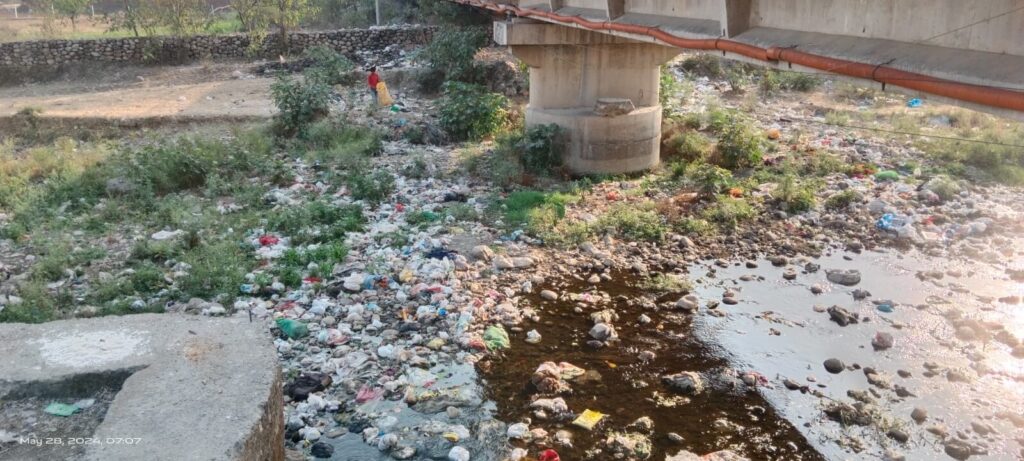
Photo: Bhim Singh Rawat
Urban India’s waste problem
India’s ban was to clamp the manufacture, distribution, stocking, sale and use of 19 single-use plastic items like cutlery, straws, sticks and thermocol (only for the purpose of decoration), while single-use plastics like carry bags and banners of a thickness of 120 microns and 100 microns respectively were allowed. It barely addressed the role of plastic in solid waste management.
India has a solid waste management problem. According to Central Pollution Control Board (CPCB) figures, urban India generated 72,368 million litres (MLD) of sewage per day between 2020 and 2021 while the installed sewage treatment capacity is about half that and operational capacity is even lower at 26,869 MLD. Only about 28 percent (20,236 MLD) is treated while the remaining 72 percent untreated waste finds its way to rivers, lakes and aquifers;[5] the plastic in it chokes the drains and waterbodies, contaminates landfills.
Desilting water bodies in cities to increase their carrying capacity and improve flow barely helps as plastic wrappers, bags, packets, and thermocol sheets float on their surface. As Nalini Sekhar, co-founder of Bengaluru-based Hasiru Dala, says, “Drains in cities were not designed to carry plastic. We have the same pipes that were laid when our cities were built, but we also have 100 houses in two apartments where there used to be 10 houses before. While the infrastructure of the drains is the same, there has been an increase in the volume of the waste. Our city plans lack vision.”
Handling plastic waste well depends on city administrations which are mostly strapped for resources, except large and rich ones like the BMC. “Broadly, city managers appear quite non-serious about the dangers of plastic waste. There is a lack of meaningful policy intervention or discourse to find effective ways to address it. Norms like segregation at source and bans have miserably failed,” says Rawat. Until the use of plastic is reduced by tailoring industrial policies, little can be done.
Waste pickers in cities find employment while ensuring that the plastics in a city’s garbage do not all go to the landfill. As Lubna Anathakrishnan, project manager at SWaCH, a cooperative for waste pickers in Pune points out, “The types of plastic banned don’t fetch prices high enough for waste pickers to want to store and sell them. Articles like plastic bags and balloon sticks are lightweight, and take space without accumulating the weight required to be sold.” Plastic packaging used for food and other multi-layered plastics (MLPs) that are a part of every major brand require effort to separate plastic components of varying thickness before they can be recycled. This burden falls on the waste pickers; they find it unaffordable because they are compensated for the material they sell, not the time and labour to clean it and make it saleable to scrap dealers.
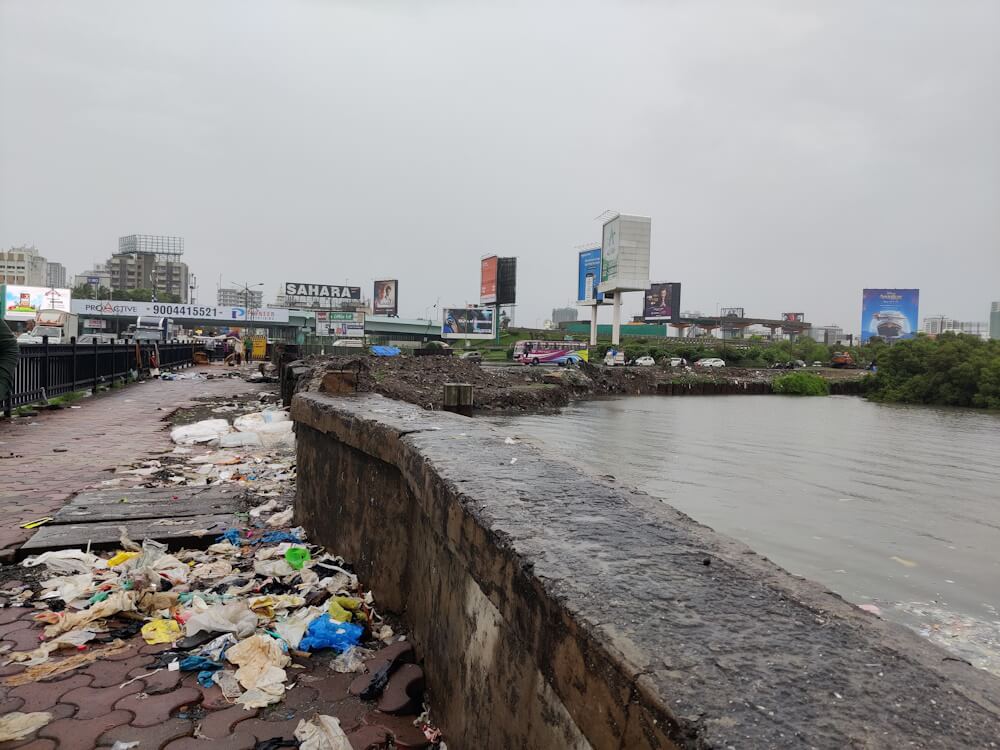
Photo: Jashvitha Dhagey
India’s waste water bodies
India has among the highest amounts of mismanaged plastic waste.[6] A study from 2021 found that close to 1,000 rivers account for 80 percent of global riverine plastic waste that goes into the world’s oceans.[7] Another study in 2018 found that three of the largest rivers in the world that carry plastic – Brahmaputra, Indus and Ganga – flow through India.
Rawat points to the practice of creating dumpyards and landfill sites close to rivers and water bodies across the country that make it easier for plastic to flow into them. “The Dadu Majra landfill in Chandigarh, Deonar in Mumbai, Bhalsawa in Delhi, Shishambara in Dehradun, Brahmapuram in Kochi, Srinagar and Uttarkashi cities of Uttarakhand are among the hundreds of such examples of this ‘trend’,” he explains.
Question of Cities also witnessed scrap dealers situated along the city’s Mithi river; their inventories included large volumes of plastic. A waste picker was picking recyclables while floating on a makeshift raft across the river. The flood of July 2005 was attributed to, among many causes, plastic waste that blocked stormwater drains. Professor Kapil Gupta from the department of civil engineering, IIT Bombay, was a part of the BMC’s flood advisory committee. “Regular cleaning of drains and other water bodies is required if we are to prevent plastics from causing pollution and flooding in our cities and towns,” he says.
In cities like Haridwar along the Ganga, most waste is directly dumped at the ghats or illegally dumped at vacant sites, found a study by the United Nations Environment Programme (UNEP).[8] The waste in Agra, situated on the banks of the Yamuna, entered the river through open drains; thin plastic sheets used in sweet shops here became a part of the river system. Yamuna, in Delhi, has been choked with plastic wrappers and guthka packets.[9]
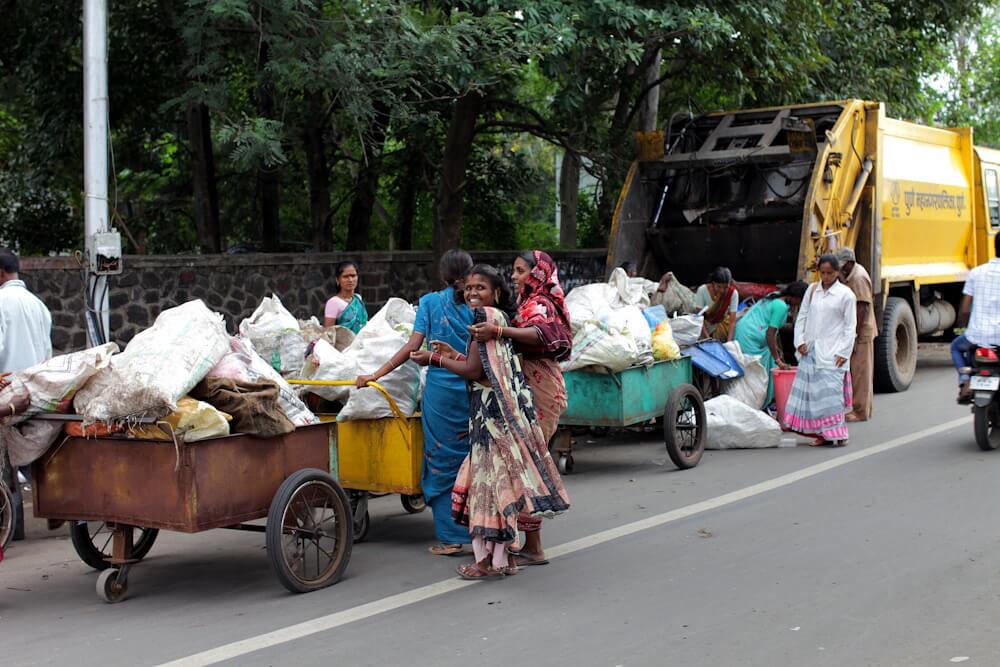
Photo: SWaCH
The way forward
Given that plastic bans have limited value, cities need to look beyond restrictions to bring down plastic waste. Segregation of plastic waste has helped to an extent. Alappuzha in Kerala, with its extensive network of canals which cannot be choked by plastic, enforces source-level segregation. Citizens’ awareness and participation in the door-to-door waste collection came through a women’s self-help group, Haritha Karma Sena. Gangtok imposed stringent bans on single-use plastic which helped to reduce the waste by limiting use.[10]
“Reduction is always the first step,” says Shekar, pointing out that people tend to use and throw single pieces thinking that one won’t make a difference. Sanitary waste like diapers and sanitary napkins, besides single-use plastics, make up a bulk of the waste. Hasiru Dala’s interventions to create awareness about sanitary waste and plastic disposal across Karnataka’s gram panchayats resulted in lowering the cost of cleaning up drains; it has yielded results in parts of Bengaluru too. Shekar finds that cities and administrators can be motivated by incentives like grants provided by Swachh Bharat and Jal Missions for good performance.
Ananthakrishnan points out that not littering is not enough. “Large companies shift their responsibility to consumers because recycling plastic is more expensive than producing virgin plastic,” she says. About recycling or upcycling, she explains, “Making a handbag out of plastic waste is a great idea. However, the rate at which handbags are used is much slower than the rate at which people go through wafer packets.” Companies that produce plastic packaging should also be responsible for reusing it after the product is used by the consumer; Extended Producer Responsibility (EPR) is an environmental policy approach. “If recycled plastics are allowed at full cost and companies using plastic are mandated to absorb recycled products, it will correct the historical debt in environmentally and socially desirable ways,” she explains.
Rawat calls for the formulation of a National Plastic Use Policy and National Plastic Waste Management Policy with effective guidelines and strict rules – and honest implementation. He concurs with Ananthakrishnan. “The policy must direct the plastic manufacturing, FMCG and other plastic packaging companies to significantly minimise use of plastic in packaging, and also to collect and recycle plastic waste generated by them.” Alternatives need to be promoted such as use of cloth bags, products with plastic-free packaging, refillable steel bottles and containers so that the generation of household plastic waste can be minimised.
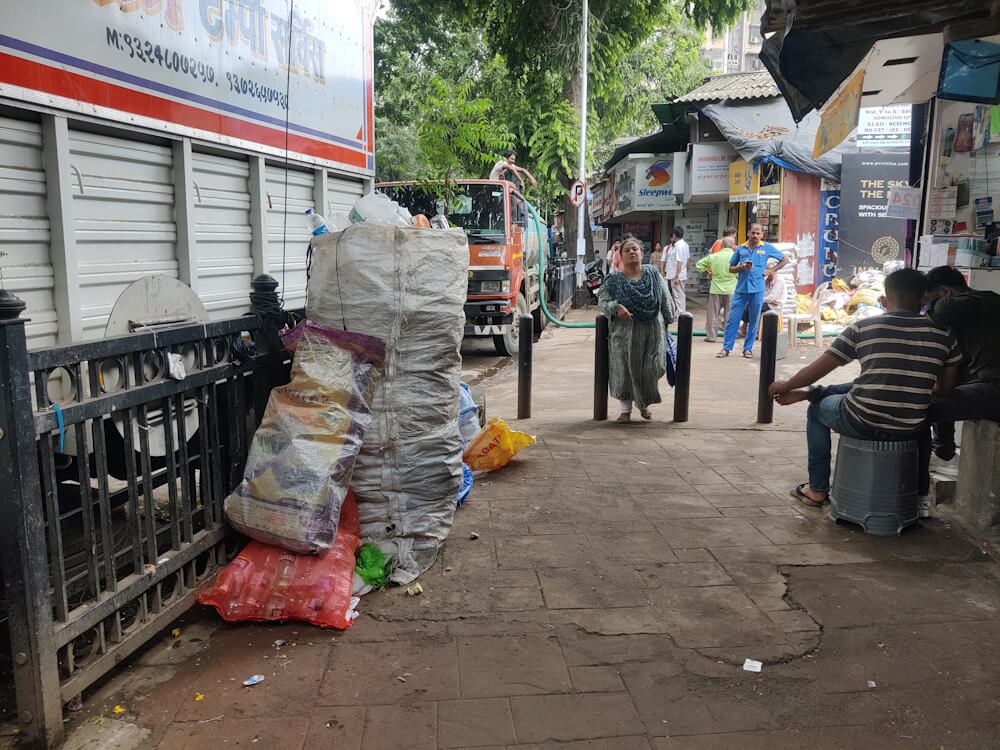
Photo: Jashvitha Dhagey
Globally, the amount of plastic waste generated is projected to triple by 2060; only 9 percent was recycled by 2022. India recycles 13 percent of its plastic waste while almost half of it is mismanaged and remains uncollected litter.[11] A study by Resource Futures found that 218 million of the world’s poorest people are at high risk of flooding aggravated by plastic pollution.[12]
India’s changing monsoon, extreme weather events, mismanagement and mindless use of plastic requires action at many levels. Roubaix, a city in France, is showing the path to a zero-waste city. Deputy mayor Alexandre Garcin initiated a volunteer-based programme in which the residents learned about making their own shampoo, deodorant, and other beauty products, reducing the need for disposable plastic bottles.[13] Even if this seems distant, people in cities across India have to be educated on limiting the consumption of plastic packaged goods. There cannot be use sans responsibility for either consumers or the supplying industries.
Jashvitha Dhagey is a multimedia journalist and researcher. A recipient of the Laadli Media Award 2023, she observes and chronicles the multiple interactions between people, between people and power, and society and media. She developed a deep interest in the way cities function, watching Mumbai at work. She holds a post-graduate diploma in Social Communications Media from Sophia Polytechnic.
Cover photo: Plastic waste washed ashore at Mahim beach in Mumbai. Credit: Jashvitha Dhagey.

